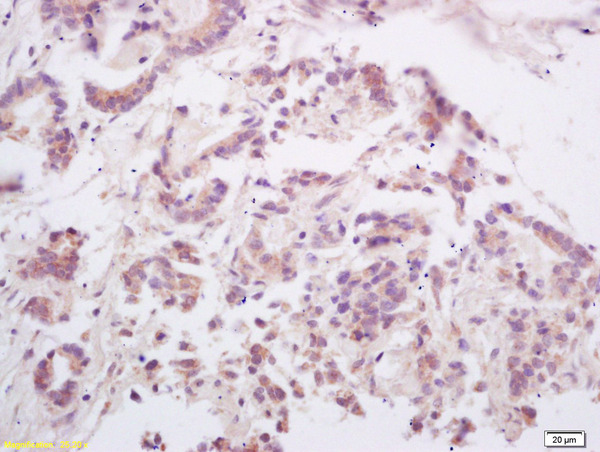RANKL antibody [C2C3], C-term
GTX108515
ApplicationsWestern Blot, ImmunoHistoChemistry, ImmunoHistoChemistry Paraffin
Product group Antibodies
ReactivityHuman, Mouse, Rat
TargetTNFSF11
Overview
- SupplierGeneTex
- Product NameRANKL antibody [C2C3], C-term
- Delivery Days Customer9
- Application Supplier NoteWB: 1:500-1:3000. IHC-P: 1:100-1:1000. *Optimal dilutions/concentrations should be determined by the researcher.Not tested in other applications.
- ApplicationsWestern Blot, ImmunoHistoChemistry, ImmunoHistoChemistry Paraffin
- CertificationResearch Use Only
- ClonalityPolyclonal
- Concentration1 mg/ml
- ConjugateUnconjugated
- Gene ID8600
- Target nameTNFSF11
- Target descriptionTNF superfamily member 11
- Target synonymsCD254, ODF, OPGL, OPTB2, RANKL, TNLG6B, TRANCE, hRANKL2, sOdf, tumor necrosis factor ligand superfamily member 11, TNF-related activation-induced cytokine, osteoclast differentiation factor, osteoprotegerin ligand, receptor activator of nuclear factor kappa B ligand, tumor necrosis factor (ligand) superfamily, member 11, tumor necrosis factor ligand 6B, tumor necrosis factor superfamily member 11
- HostRabbit
- IsotypeIgG
- Protein IDO14788
- Protein NameTumor necrosis factor ligand superfamily member 11
- Scientific DescriptionThis gene encodes a member of the tumor necrosis factor (TNF) cytokine family which is a ligand for osteoprotegerin and functions as a key factor for osteoclast differentiation and activation. This protein was shown to be a dentritic cell survival factor and is involved in the regulation of T cell-dependent immune response. T cell activation was reported to induce expression of this gene and lead to an increase of osteoclastogenesis and bone loss. This protein was shown to activate antiapoptotic kinase AKT/PKB through a signaling complex involving SRC kinase and tumor necrosis factor receptor-associated factor (TRAF) 6, which indicated this protein may have a role in the regulation of cell apoptosis. Targeted disruption of the related gene in mice led to severe osteopetrosis and a lack of osteoclasts. The deficient mice exhibited defects in early differentiation of T and B lymphocytes, and failed to form lobulo-alveolar mammary structures during pregnancy. Two alternatively spliced transcript variants have been found. [provided by RefSeq]
- ReactivityHuman, Mouse, Rat
- Storage Instruction-20°C or -80°C,2°C to 8°C
- UNSPSC12352203
References
- Tenshin H, Teramachi J, Ashtar M, et al. TGF-β-activated kinase-1 inhibitor LL-Z1640-2 reduces joint inflammation and bone destruction in mouse models of rheumatoid arthritis by inhibiting NLRP3 inflammasome, TACE, TNF-α and RANKL expression. Clin Transl Immunology. 2022,11(1):e1371. doi: 10.1002/cti2.1371Read this paper
- Yeom J, Ma S, Lim YH. Probiotic Propionibacterium freudenreichii MJ2 Enhances Osteoblast Differentiation and Mineralization by Increasing the OPG/RANKL Ratio. Microorganisms. 2021,9(4). doi: 10.3390/microorganisms9040673Read this paper
- Malta FS, Garcia RP, Azarias JS, et al. Impact of hyperglycemia and treatment with metformin on ligature-induced bone loss, bone repair and expression of bone metabolism transcription factors. PLoS One. 2020,15(8):e0237660. doi: 10.1371/journal.pone.0237660Read this paper
- Zhang Y, Zhou L, Li S, et al. Impacts of lead exposure and chelation therapy on bone metabolism during different developmental stages of rats. Ecotoxicol Environ Saf. 2019,183:109441. doi: 10.1016/j.ecoenv.2019.109441Read this paper
- Chang MC, Chen YJ, Lian YC, et al. Butyrate Stimulates Histone H3 Acetylation, 8-Isoprostane Production, RANKL Expression, and Regulated Osteoprotegerin Expression/Secretion in MG-63 Osteoblastic Cells. Int J Mol Sci. 2018,19(12). doi: 10.3390/ijms19124071Read this paper







